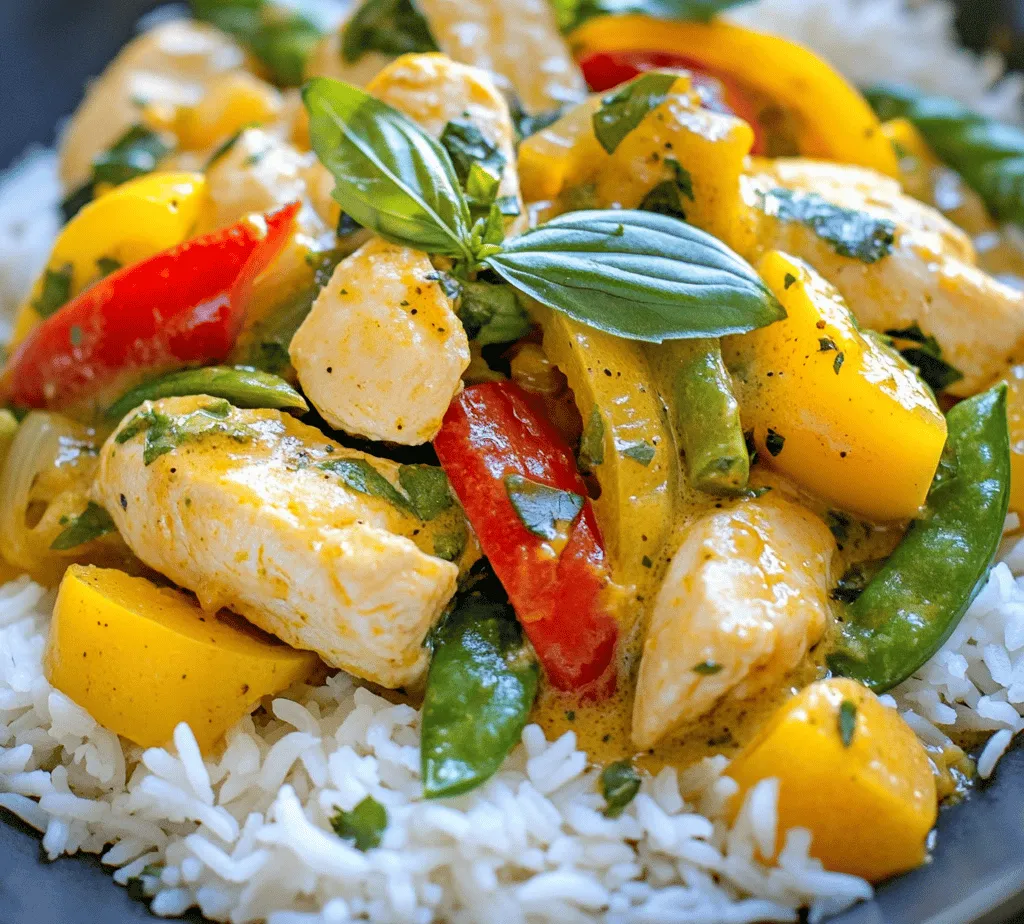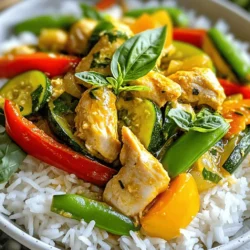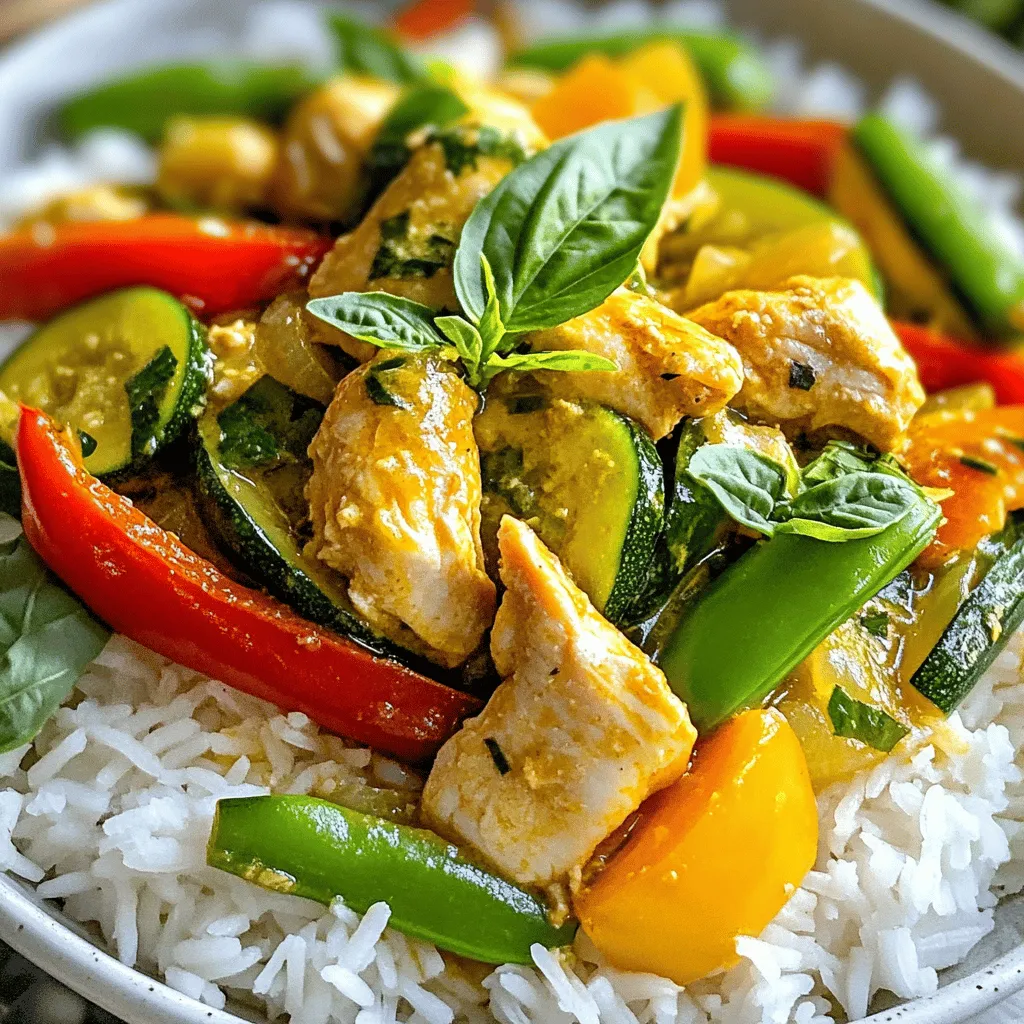Introduction
Thai cuisine is celebrated around the world for its vibrant flavors, aromatic herbs, and diverse ingredients. A culinary tapestry woven with influences from neighboring countries and its own rich traditions, Thai food offers an unforgettable experience with every bite. Among the plethora of dishes that define this captivating cuisine, Thai Green Curry Delight stands out as a quintessential representative, showcasing a harmonious blend of flavors that tantalize the palate.
This dish is more than just a meal; it is a symbol of Thai cooking’s emphasis on freshness and balance. Thai Green Curry is known for its striking green color, derived from fresh herbs and vegetables, and its creamy texture, achieved through the inclusion of coconut milk. It is a perfect example of how Thai cuisine celebrates the use of fresh ingredients and authentic flavors. Whether enjoyed at a bustling street market or a cozy family gathering, this dish is sure to evoke a sense of comfort and satisfaction.
In preparing a Thai Green Curry, the importance of using fresh ingredients cannot be overstated. The vibrant flavors characteristic of Thai cooking come from the careful selection and combination of herbs, spices, and produce. In this recipe, we’ll explore how each component contributes to the overall experience of this delightful dish, ensuring you achieve an authentic taste right in your own kitchen.
Understanding Thai Green Curry
At its core, Thai Green Curry is a dish that epitomizes the balance of flavors inherent in Thai cuisine. It is a coconut milk-based curry that is both fragrant and flavorful, typically featuring a protein such as chicken, beef, or tofu, along with an array of colorful vegetables. The signature element of the dish is the green curry paste, which combines green chilies, garlic, lemongrass, and other aromatic ingredients to create a spicy and complex flavor profile.
The beauty of Thai Green Curry lies in its versatility. While the traditional recipe may call for specific proteins and vegetables, it can easily be adapted to suit personal preferences or dietary needs. The rich coconut milk provides a creamy backdrop that carries the other ingredients, while the green curry paste adds a layer of heat, making for an irresistible combination.
Balancing flavors is paramount in crafting an authentic Thai Green Curry. The interplay of sweet, salty, sour, and spicy notes creates a multidimensional experience. Commonly, sweetness is introduced through brown sugar, while saltiness comes from fish sauce. Lime juice adds acidity, brightening the dish, and the heat can be adjusted based on the amount of curry paste used. Understanding this balance is key to mastering Thai Green Curry, allowing you to create a dish that is both satisfying and full of life.
Ingredients Breakdown
To create a truly memorable Thai Green Curry Delight, it is essential to use high-quality, fresh ingredients. Below is a detailed breakdown of each component that contributes to this dish’s depth of flavor.
Chicken Breast
Chicken breast is a popular choice for protein in Thai Green Curry due to its lean nature and ability to absorb flavors. It cooks quickly and remains tender when prepared correctly. For the best results, select skinless, boneless chicken breasts, and slice them into bite-sized pieces. This will ensure that they cook evenly and can easily soak up the delicious curry sauce. Additionally, chicken is an excellent source of protein, making this dish a nutritious option for any meal.
Green Curry Paste
Green curry paste is the heart of this dish, providing the distinctive flavor that sets it apart from other curries. Typically made from a blend of fresh green chilies, garlic, shallots, lemongrass, galangal, and various herbs, the paste is a powerhouse of flavor. While you can find pre-made green curry paste in stores, making your own can elevate the dish to new heights. The freshness of the ingredients will enhance the overall taste of your curry, making the effort worthwhile.
Coconut Milk
Coconut milk is another key ingredient that contributes to the dish’s rich, creamy texture. It acts as the base for the curry, offering a soothing contrast to the heat from the green curry paste. When selecting coconut milk, opt for full-fat varieties for a richer flavor and creamier consistency. The natural sweetness of coconut milk pairs perfectly with the spices and herbs, creating a delightful balance in every spoonful.
Chicken Broth
Incorporating chicken broth into your Thai Green Curry enhances the flavor depth of the dish. Using homemade chicken stock, when possible, is ideal, as it provides a more robust taste compared to store-bought options. The broth helps to create a saucy consistency while enriching the overall flavor profile of the curry. If you prefer a vegetarian version, vegetable broth can be used as a substitute.
Bell Peppers
Bell peppers add a pop of color and crunch to the curry, making them an essential component of the dish. They are not only visually appealing but also rich in vitamins A and C, contributing to the overall health benefits of the meal. When preparing your curry, choose a mix of colored bell peppers—red, yellow, and green—to enhance both flavor and presentation. Slice them into thin strips for an appealing texture that complements the other ingredients.
Zucchini
Zucchini lends a mild flavor and a pleasant texture to Thai Green Curry. It cooks quickly and absorbs the flavors of the curry sauce, making it a great addition. Furthermore, zucchini is low in calories and provides dietary fiber, which is beneficial for digestion. Cut the zucchini into half-moon shapes or rounds to ensure even cooking and a delightful bite.
Snap Peas
Snap peas are known for their crispness and sweetness, making them a delightful addition to Thai Green Curry. They add freshness to the dish and a satisfying crunch. Rich in vitamins and minerals, including vitamin C and folate, snap peas enhance the nutritional profile of your meal. Simply trim the ends and toss them in towards the end of cooking to preserve their texture.
Fish Sauce
A staple in many Thai dishes, fish sauce provides an essential umami flavor, enhancing the overall taste of the curry. Made from fermented fish, it may seem daunting at first, but it is a key ingredient that adds depth and complexity. When using fish sauce, start with a small amount and adjust to taste, as it can be quite potent. For a vegetarian alternative, soy sauce or a vegan fish sauce can be substituted.
Brown Sugar
Brown sugar serves as a balancing agent in Thai Green Curry, counteracting the heat from the spices and the saltiness from the fish sauce. The caramel notes of brown sugar add warmth and depth to the dish. When adding brown sugar, do so gradually, tasting as you go to find the perfect balance that suits your palate.
Lime Juice
Lime juice is vital for adding brightness to Thai Green Curry. Its acidity cuts through the richness of the coconut milk, providing a refreshing contrast. Freshly squeezed lime juice is recommended over bottled varieties, as it delivers a vibrant flavor that enhances the dish’s freshness. Squeeze the lime juice in just before serving to preserve its zesty flavor.
Kaffir Lime Leaves
Kaffir lime leaves are a unique ingredient that imparts a distinct aroma and flavor to Thai Green Curry. Their citrusy fragrance elevates the dish, adding an additional layer of complexity. To use, simply tear the leaves to release their oils and add them to the curry during cooking. If fresh leaves are unavailable, dried kaffir lime leaves can be used as a substitute.
Fresh Basil Leaves
Fresh basil leaves, particularly Thai basil, are the final touch that brings your Thai Green Curry to life. Their aromatic flavor adds a burst of freshness that elevates the dish. Just before serving, toss in a handful of fresh basil leaves to allow their essential oils to infuse the curry. If you cannot find Thai basil, regular sweet basil can be used, though the flavor will differ slightly.
Jasmine Rice
Traditionally served alongside Thai Green Curry, jasmine rice is the ideal accompaniment. Its fragrant aroma and slightly sticky texture provide a perfect base for the rich and flavorful curry. To prepare jasmine rice, rinse it under cold water until the water runs clear, then cook it according to package instructions. The fluffy grains will soak up the curry sauce beautifully, creating a satisfying meal.
Preparation Steps
Before diving into cooking, it’s essential to prepare your ingredients to ensure a smooth cooking process. Here’s a detailed guide on how to prepare each component for your Thai Green Curry Delight:
1. Chicken Preparation: Start by trimming any excess fat from the chicken breasts. Slice the chicken into bite-sized pieces, approximately 1-inch cubes. This size will allow for even cooking and make it easy to enjoy in the curry.
2. Vegetable Preparation: Begin with the bell peppers by removing the stems and seeds. Slice the peppers into thin strips. For the zucchini, cut off the ends and slice it into half-moon shapes, about ½ inch thick. Lastly, trim the ends of the snap peas.
3. Herbs and Aromatics: If using fresh kaffir lime leaves, tear them into pieces to release their oils. Rinse the fresh basil leaves under cold water to remove any dirt, and gently pat them dry with a paper towel. Prepare your lime by cutting it in half, ready for juicing.
4. Curry Paste: If you are using store-bought green curry paste, have it ready. If you’re making your own, prepare the fresh ingredients (green chilies, garlic, lemongrass, etc.) and blend them until smooth. This step can be made ahead of time for added convenience.
By following these preparation steps, you will create a well-organized cooking environment that allows you to focus on crafting the perfect Thai Green Curry Delight. The meticulous preparation of ingredients not only enhances the cooking process but also ensures that each component shines in the final dish. As you gather your ingredients and prepare to bring this delightful recipe to life, the anticipation of savoring the authentic flavors of Thailand will surely inspire your culinary adventure.



